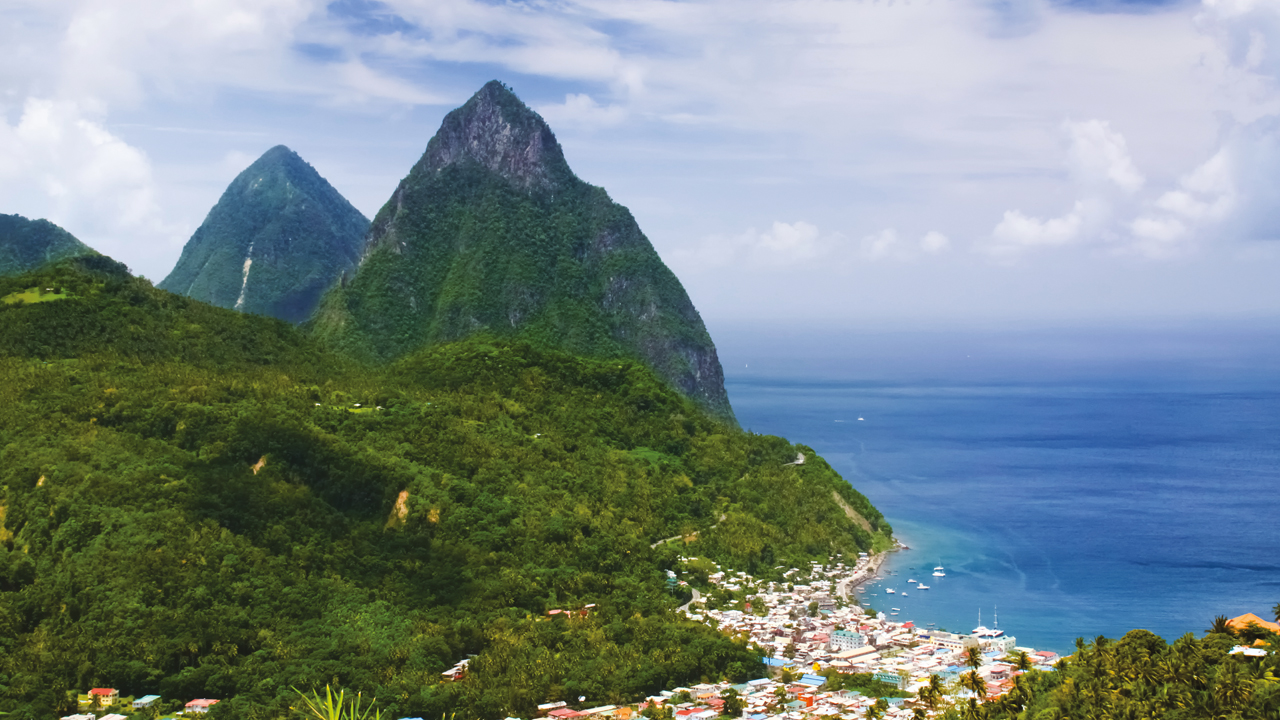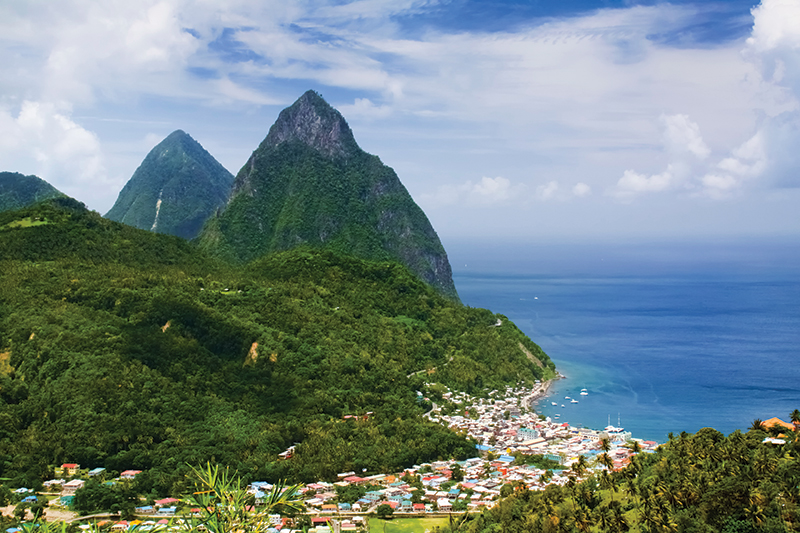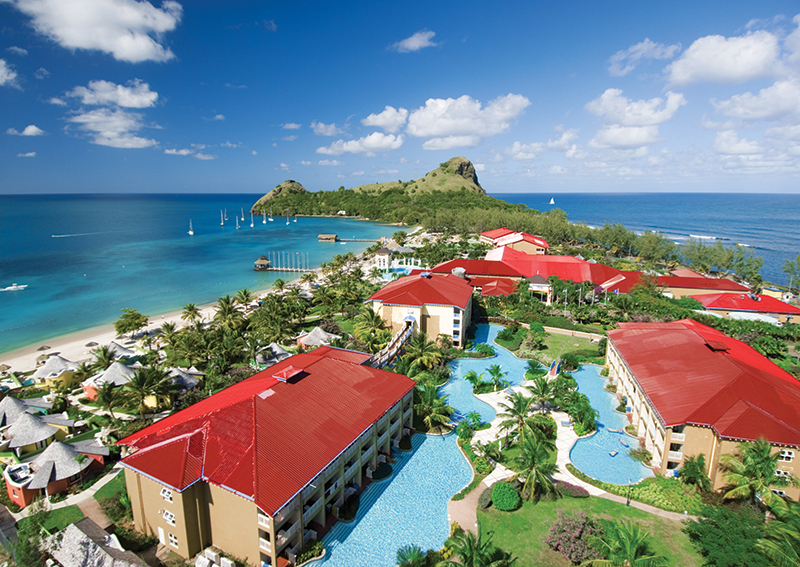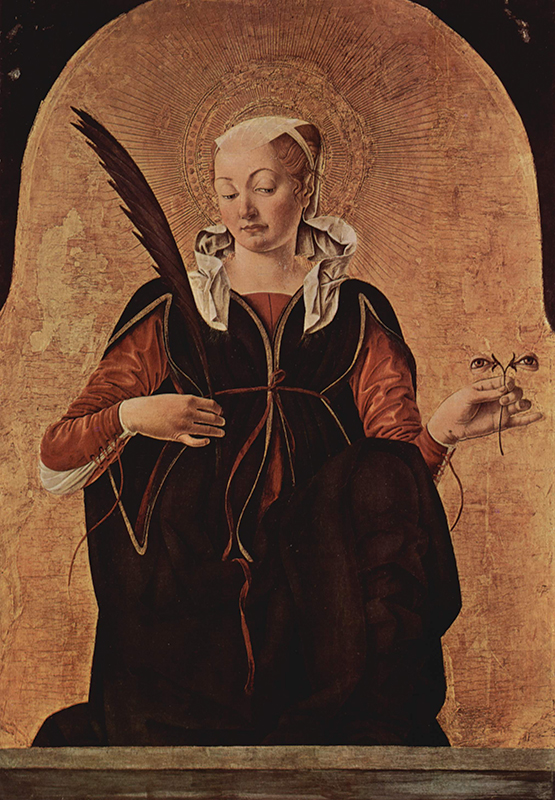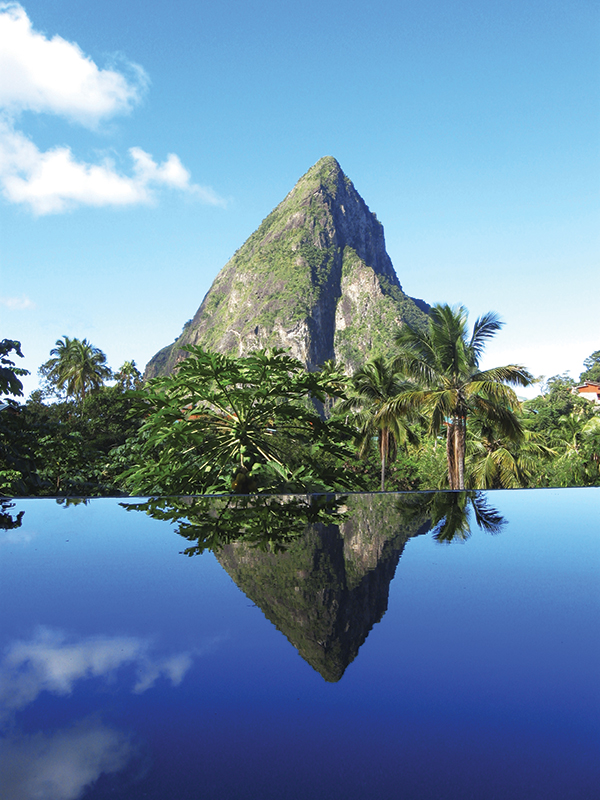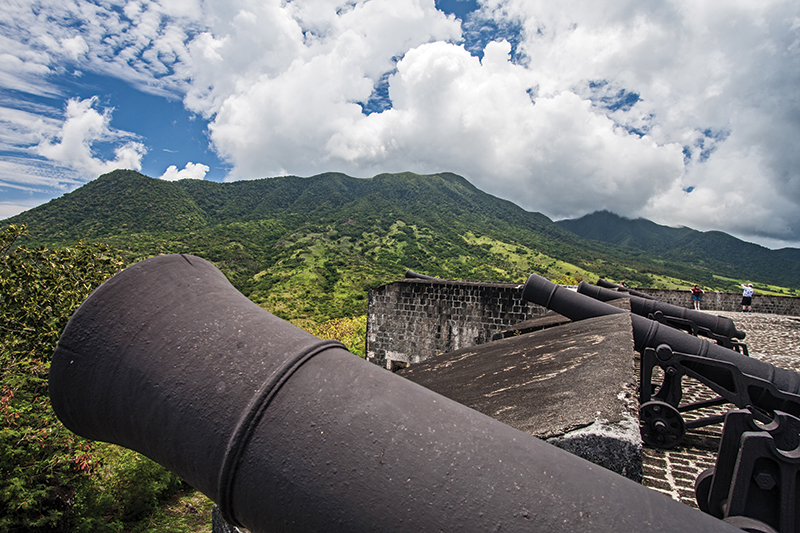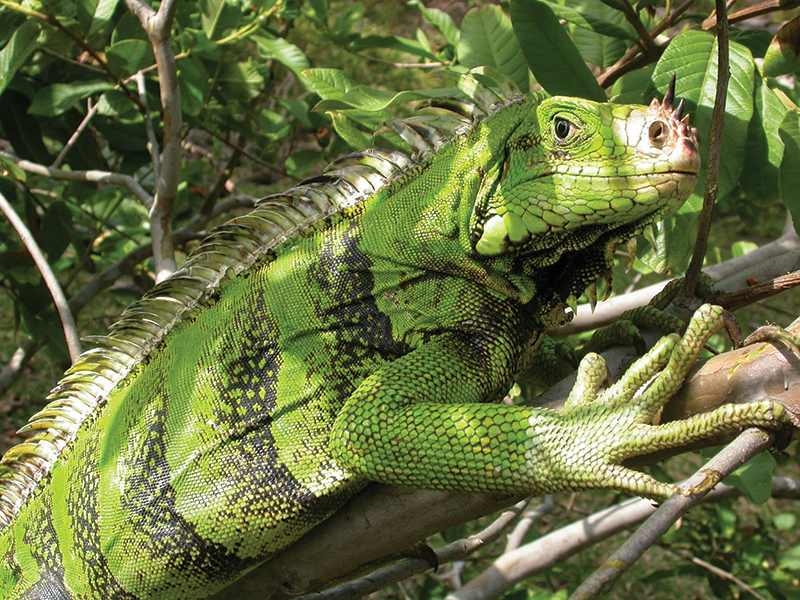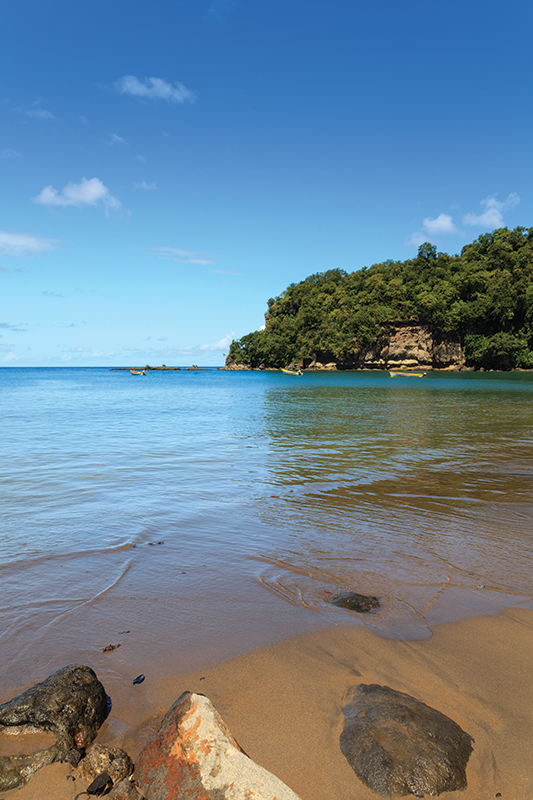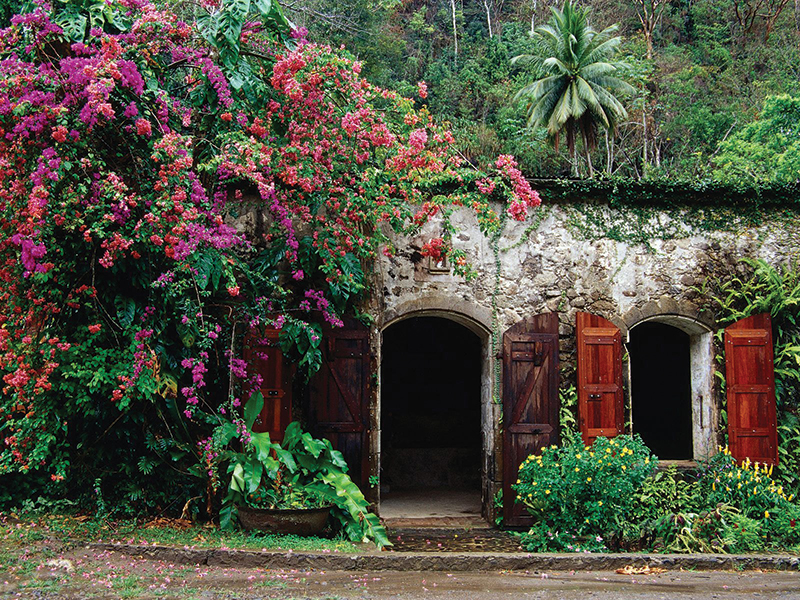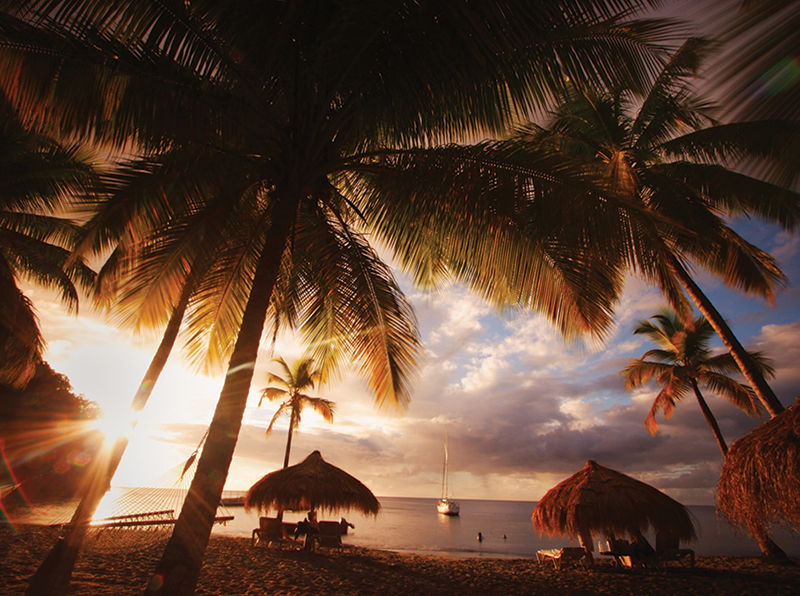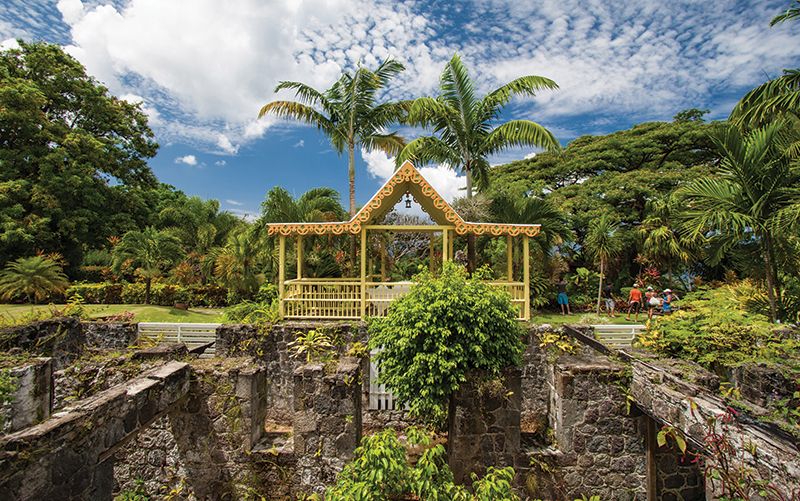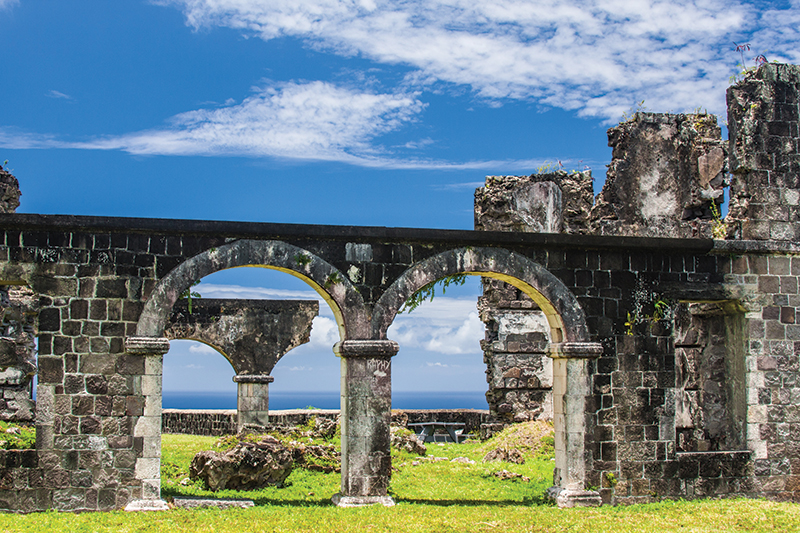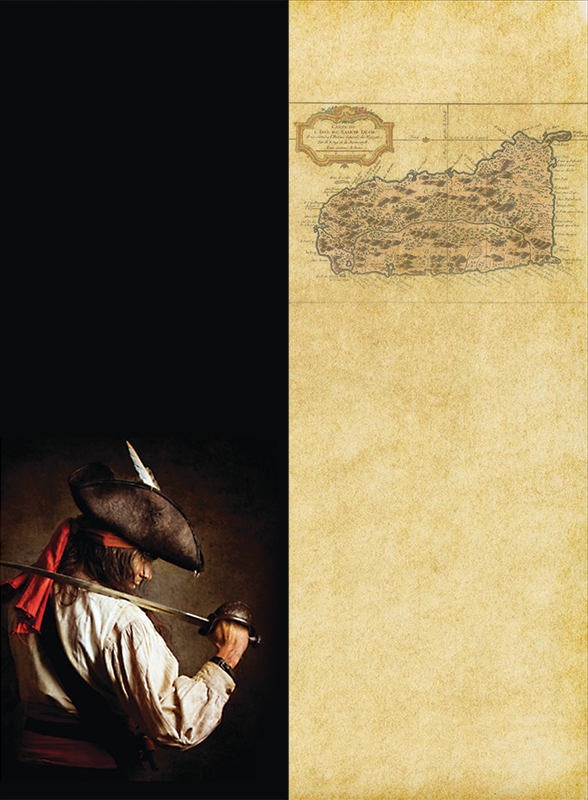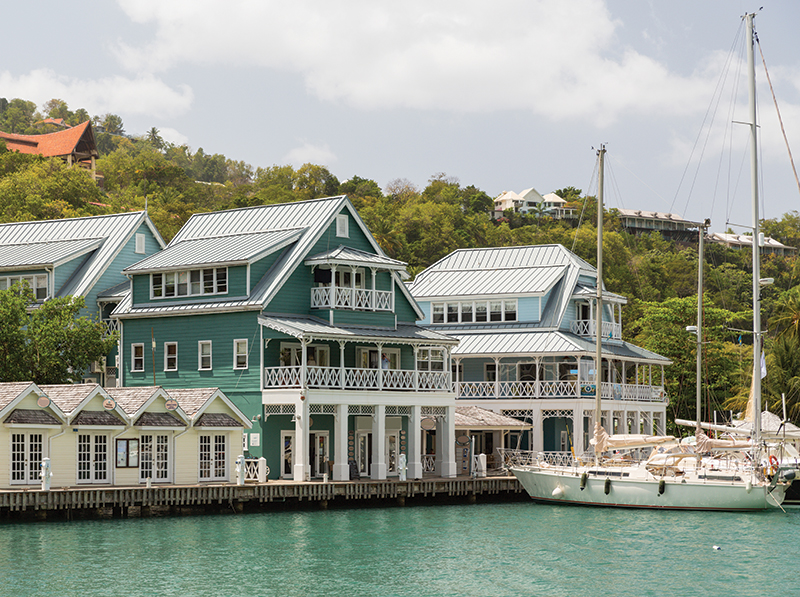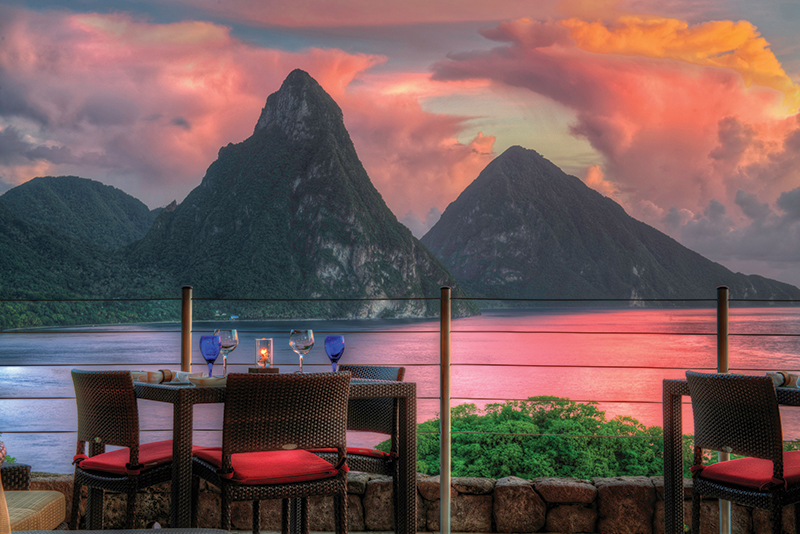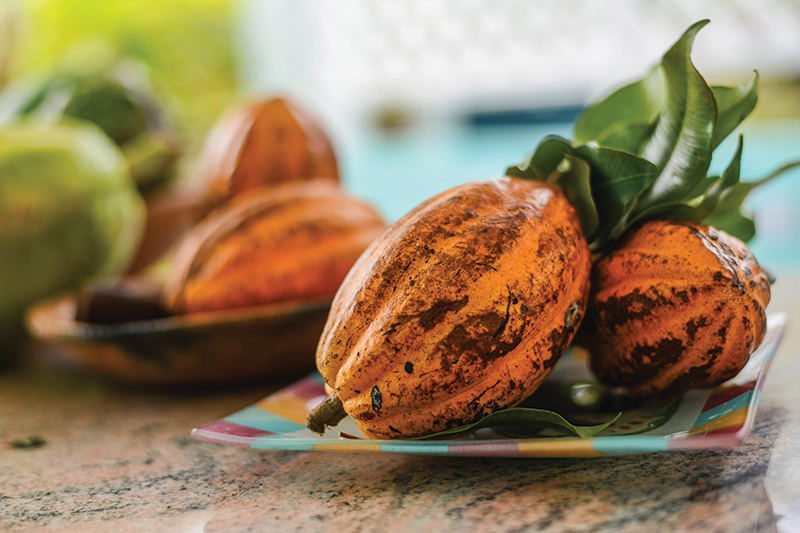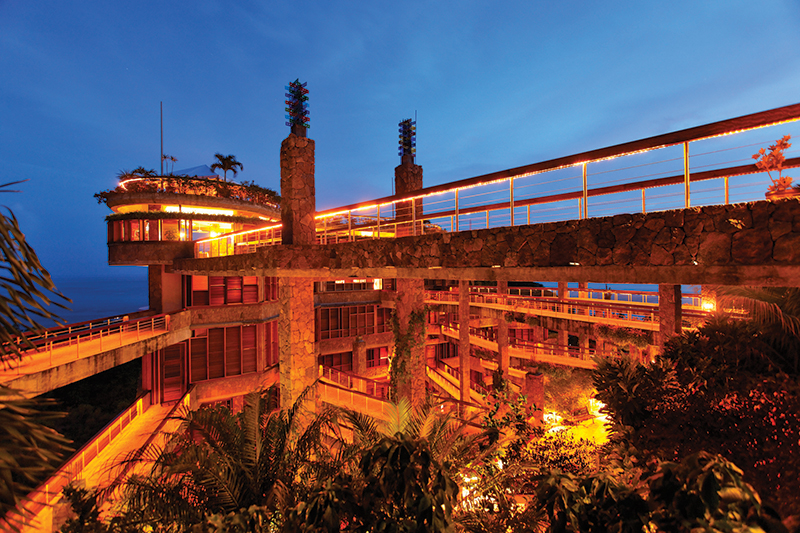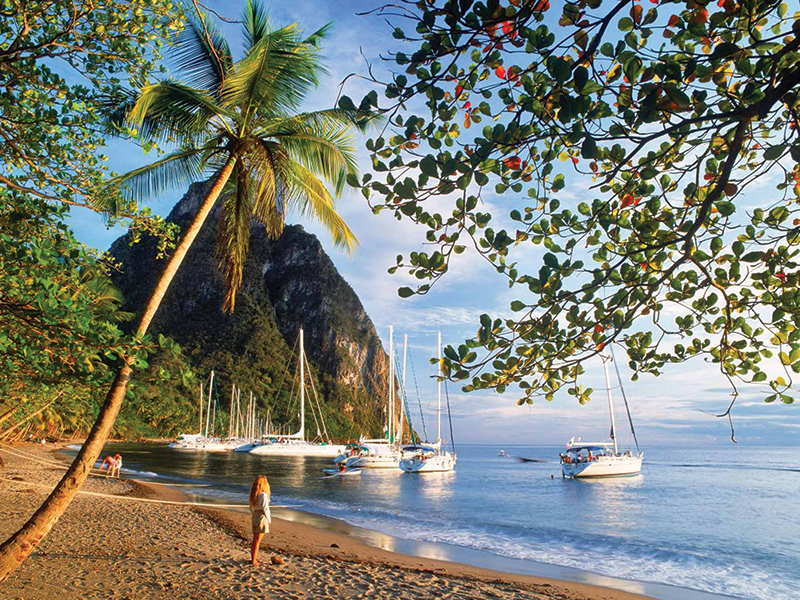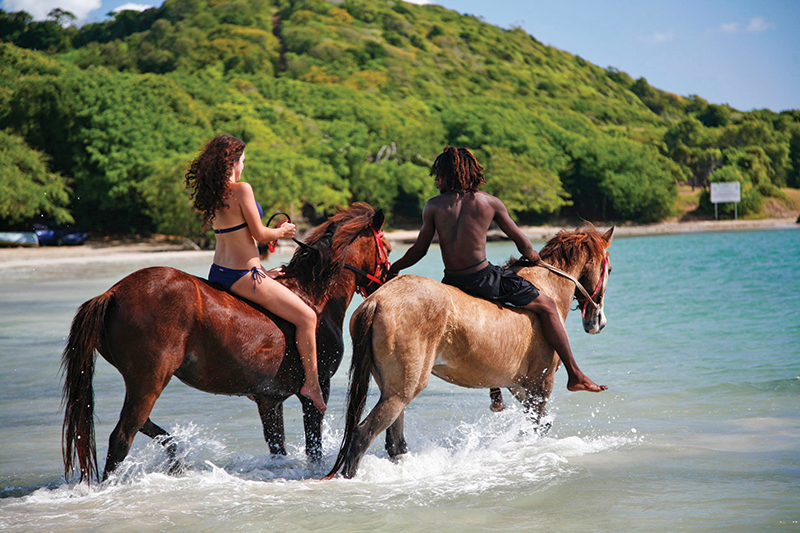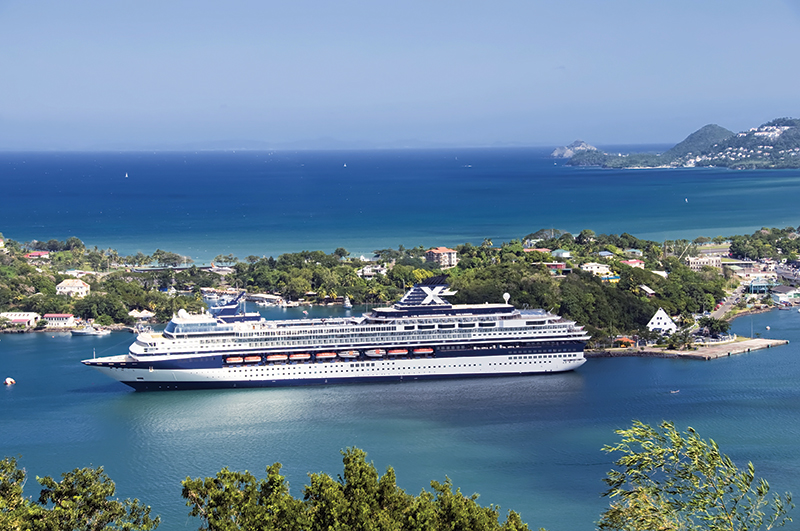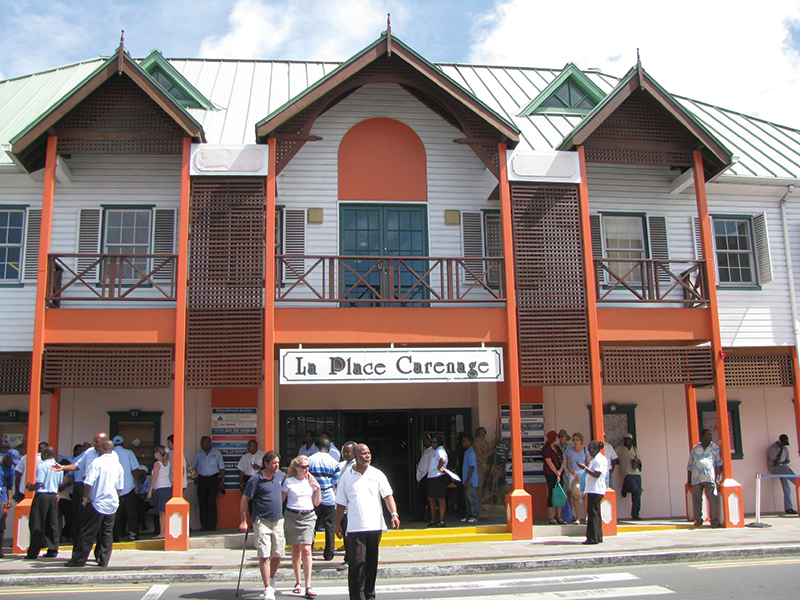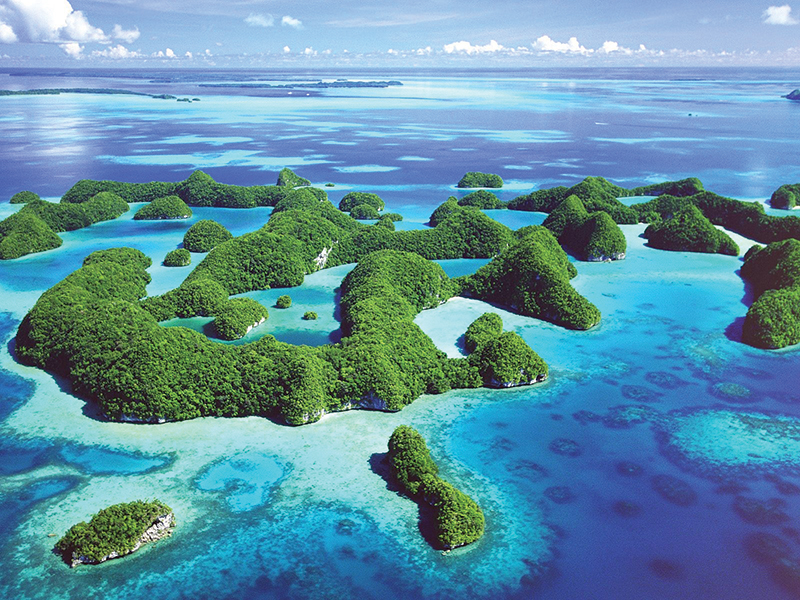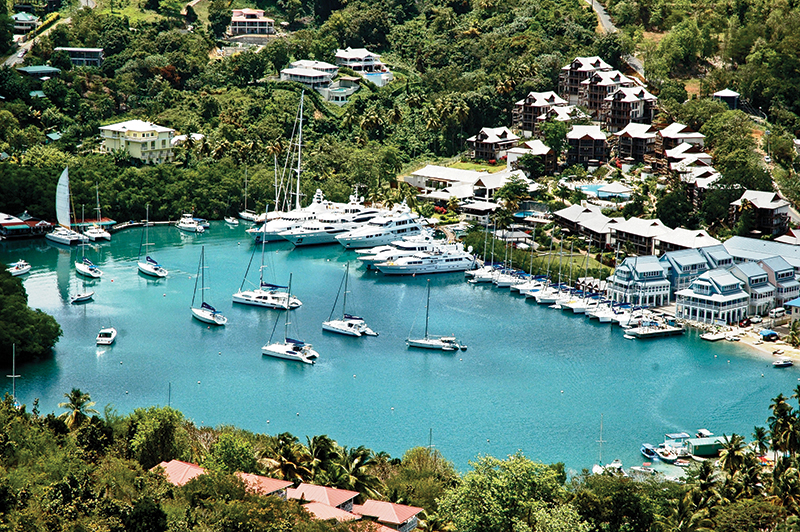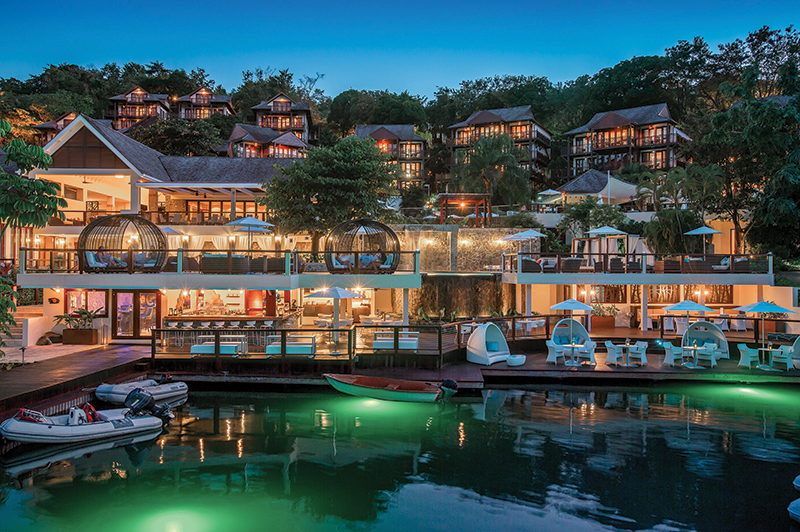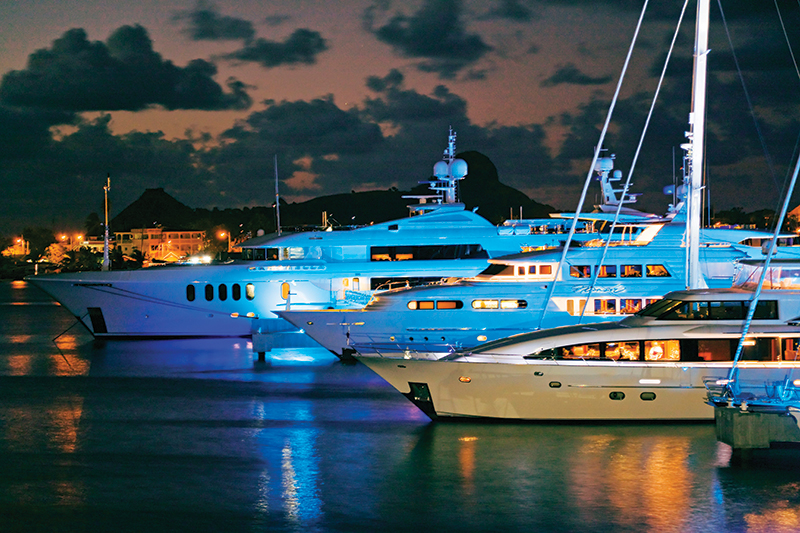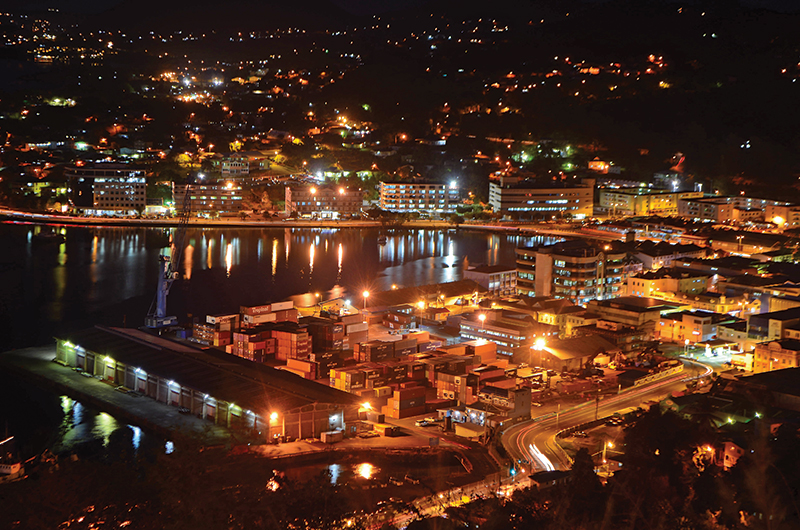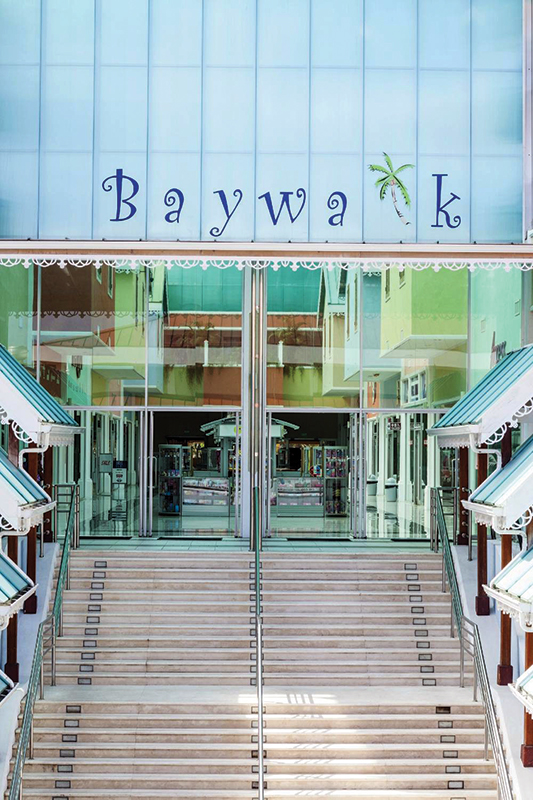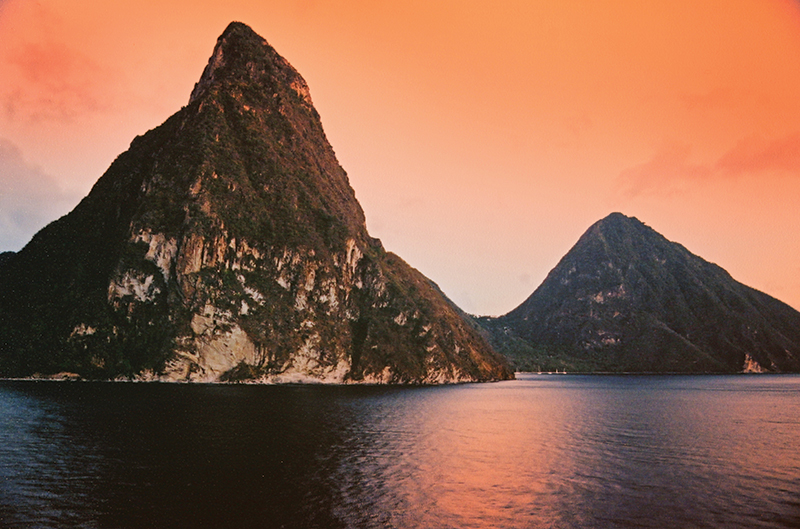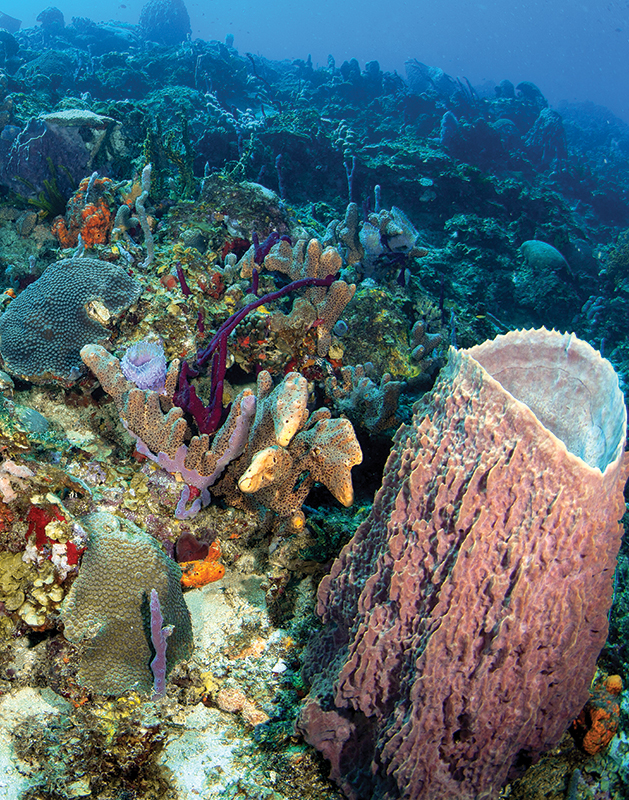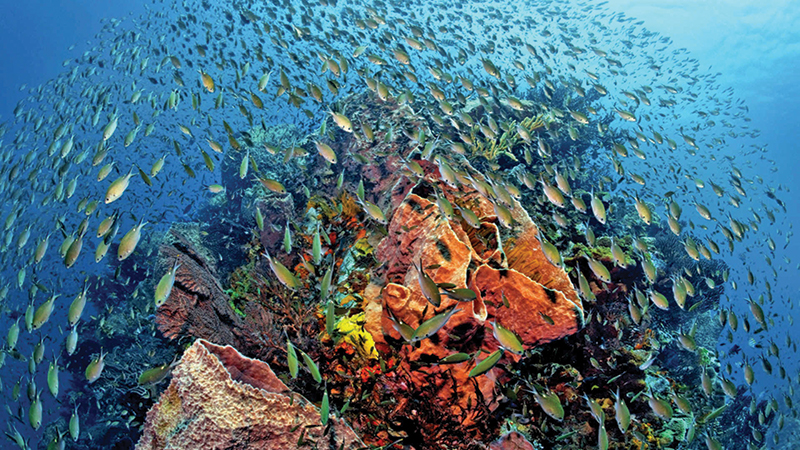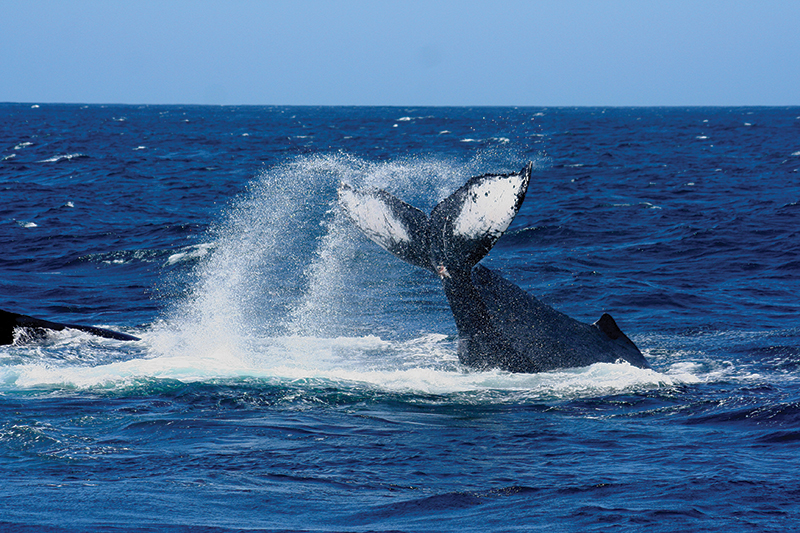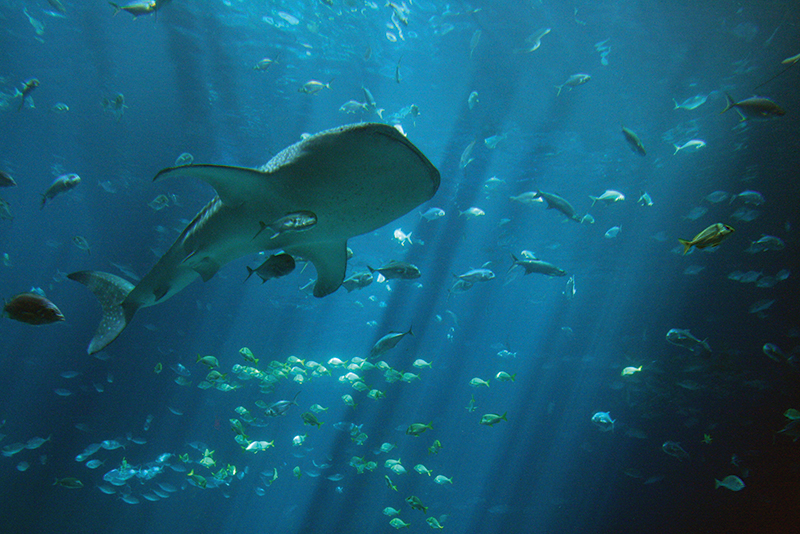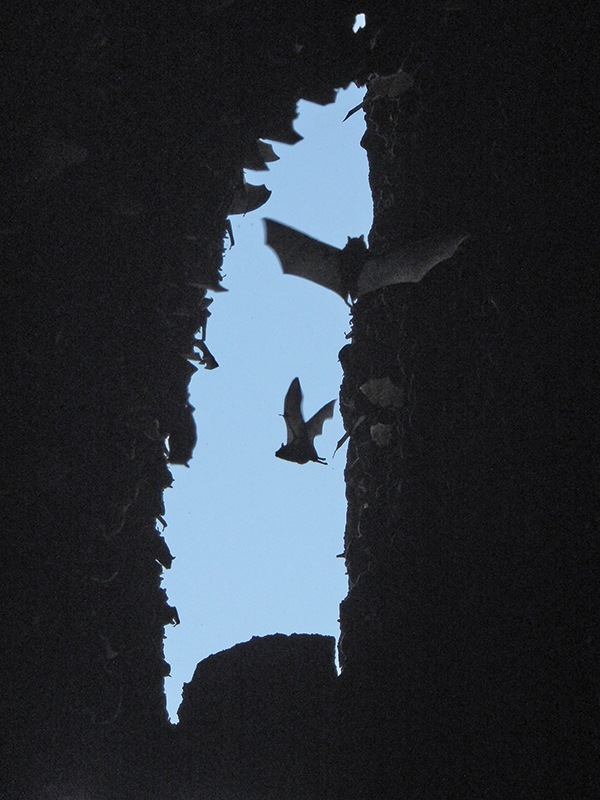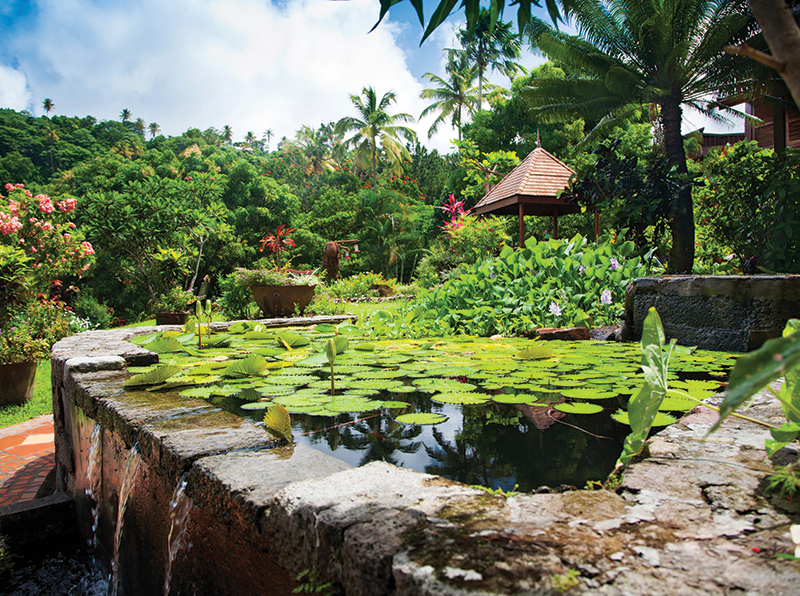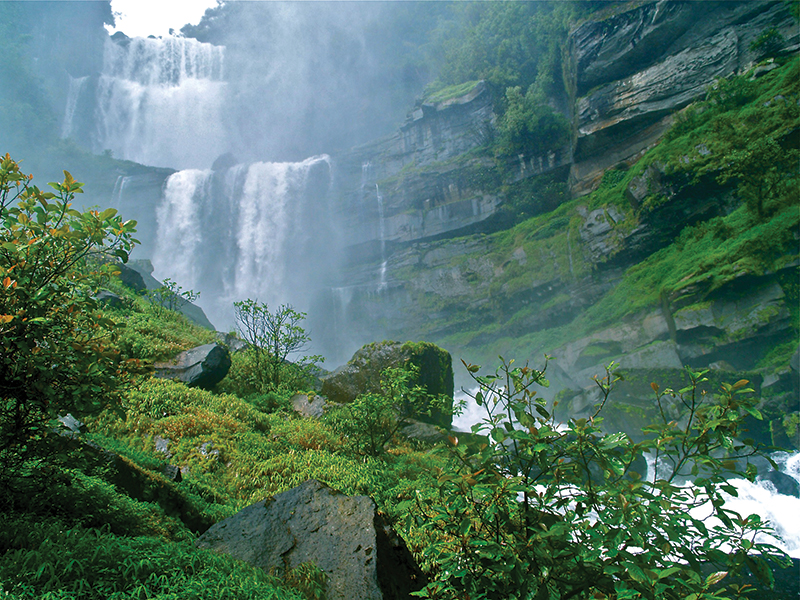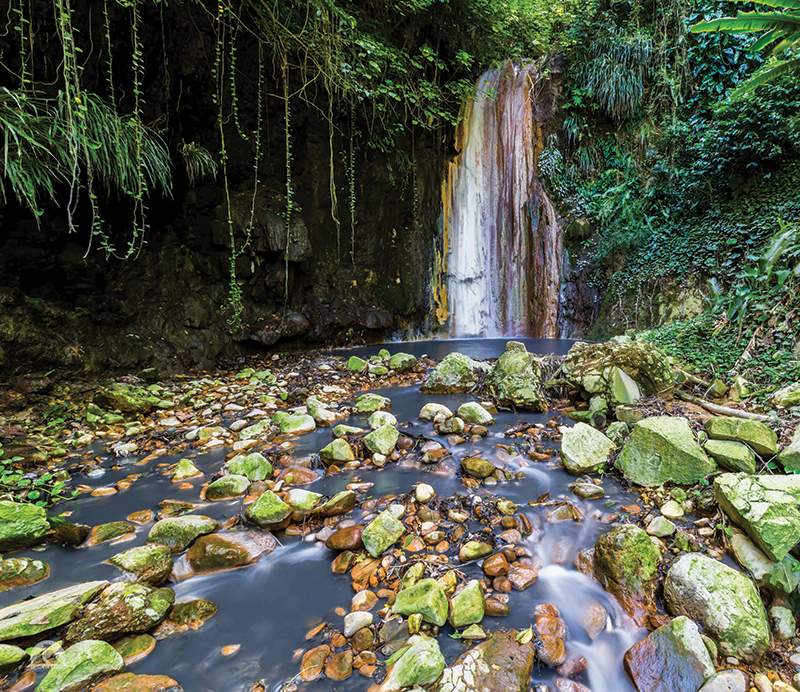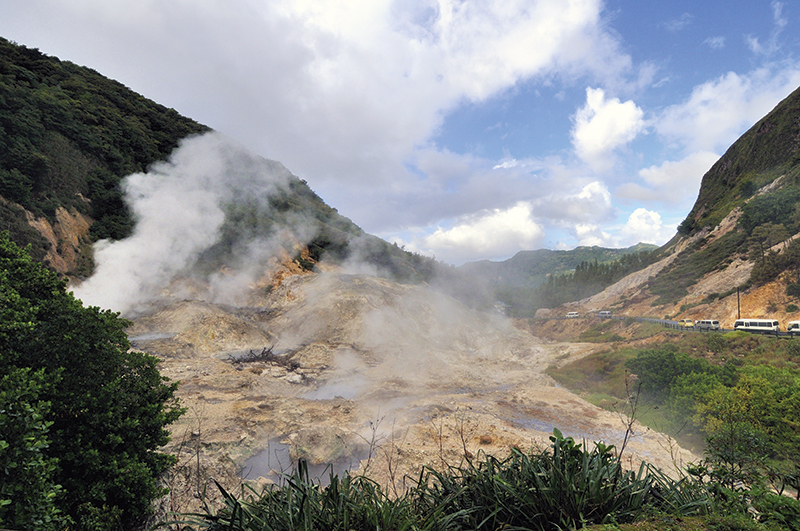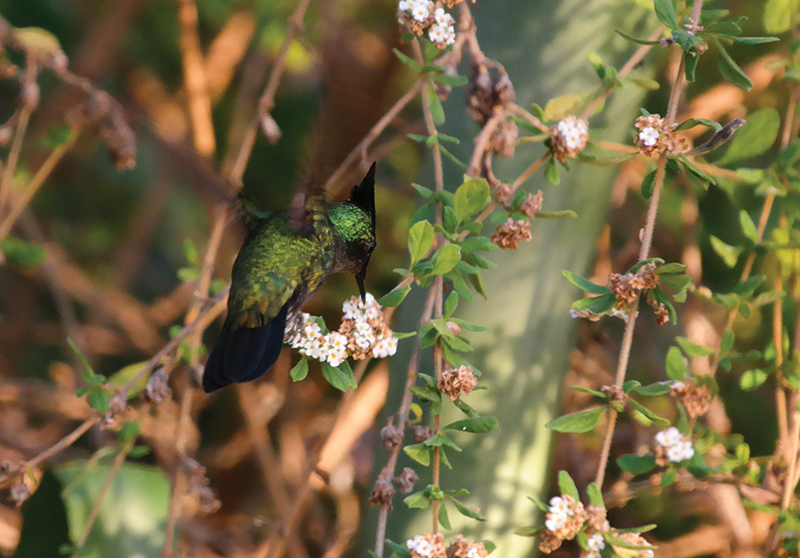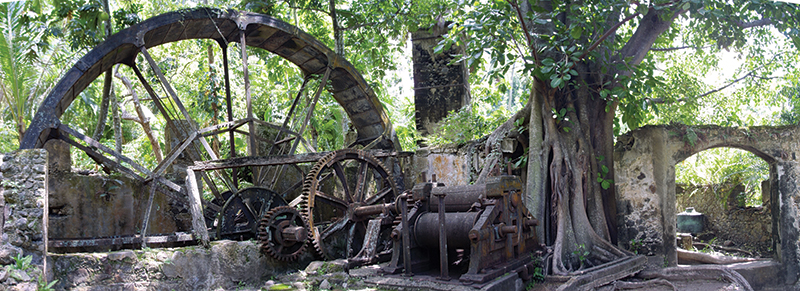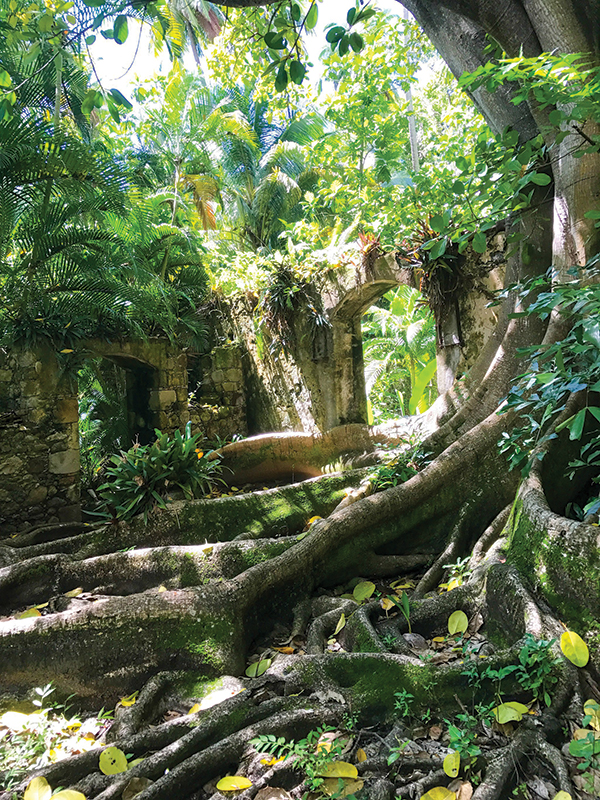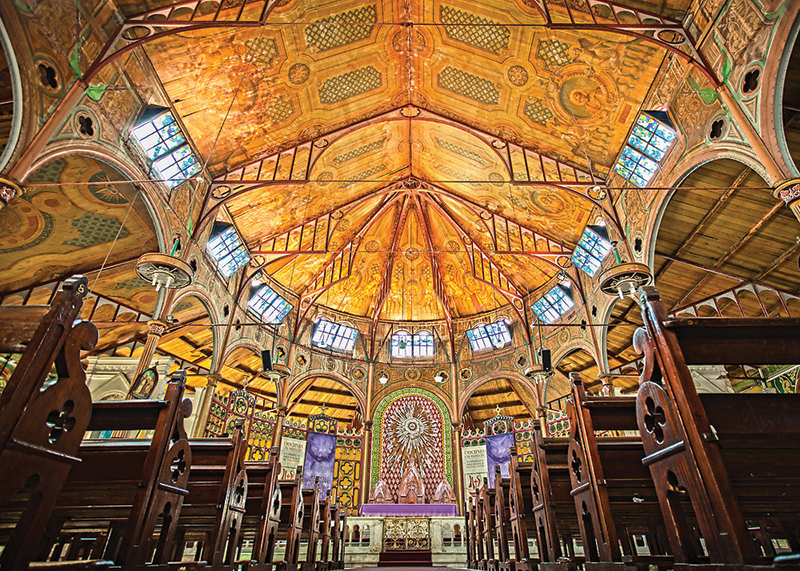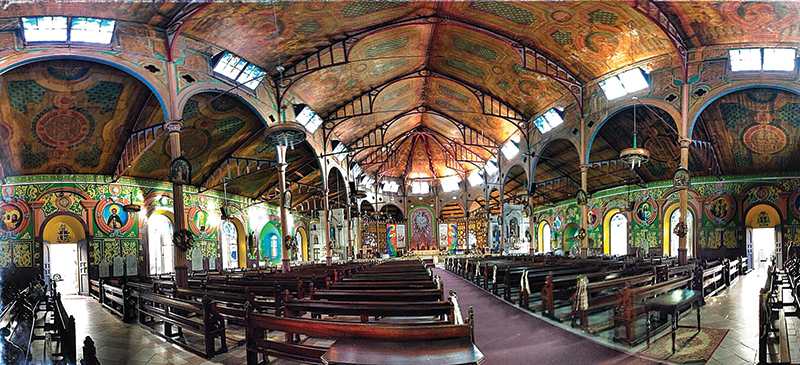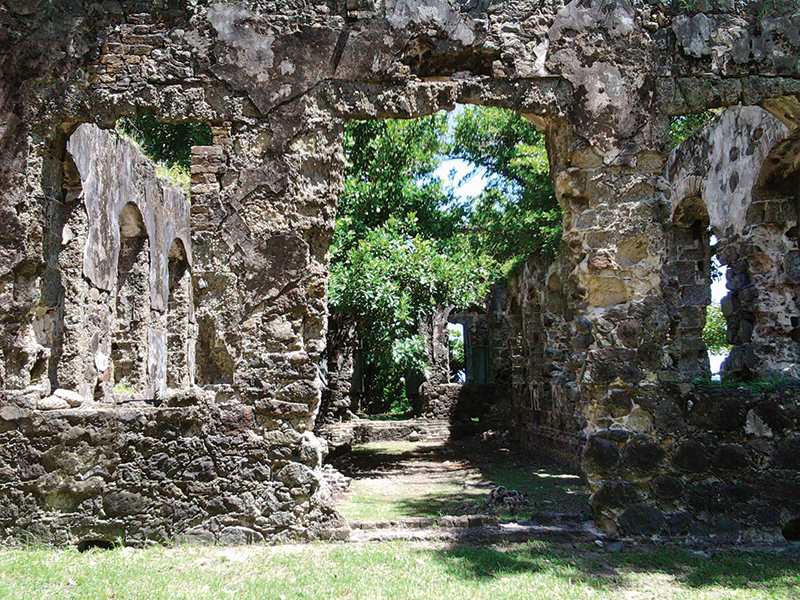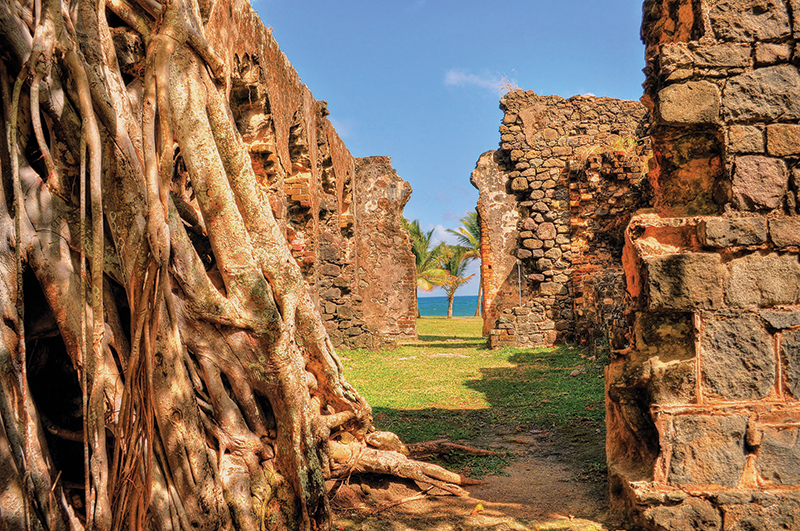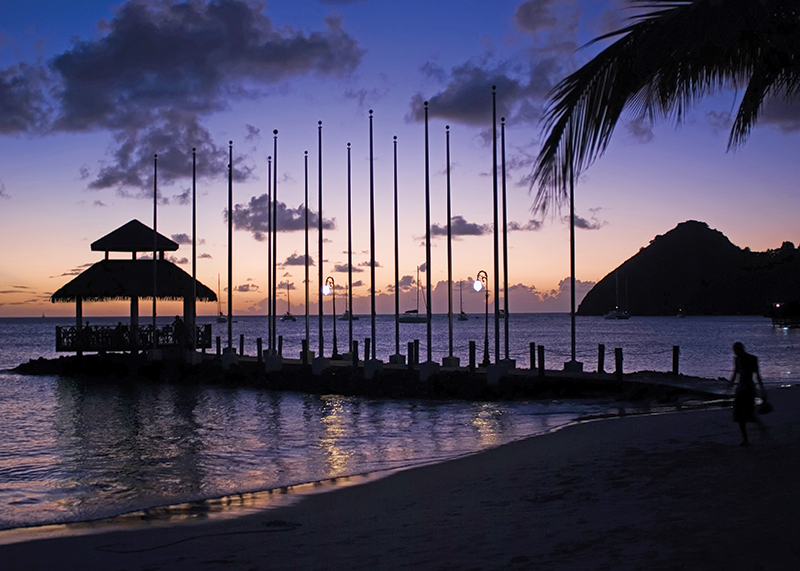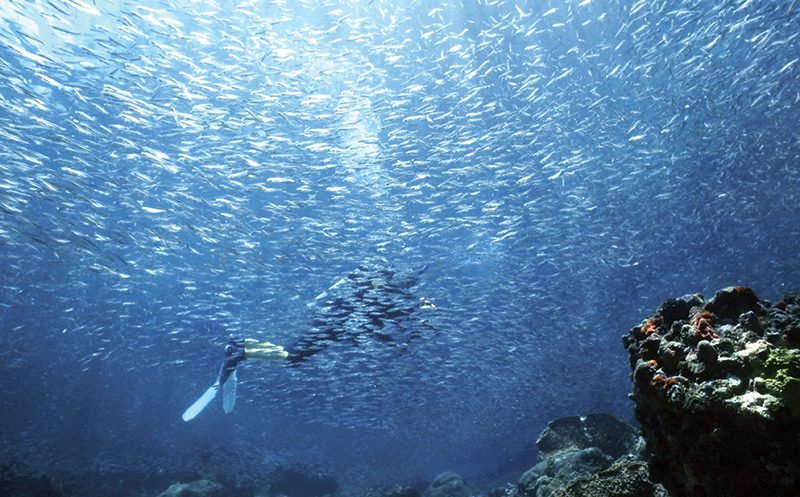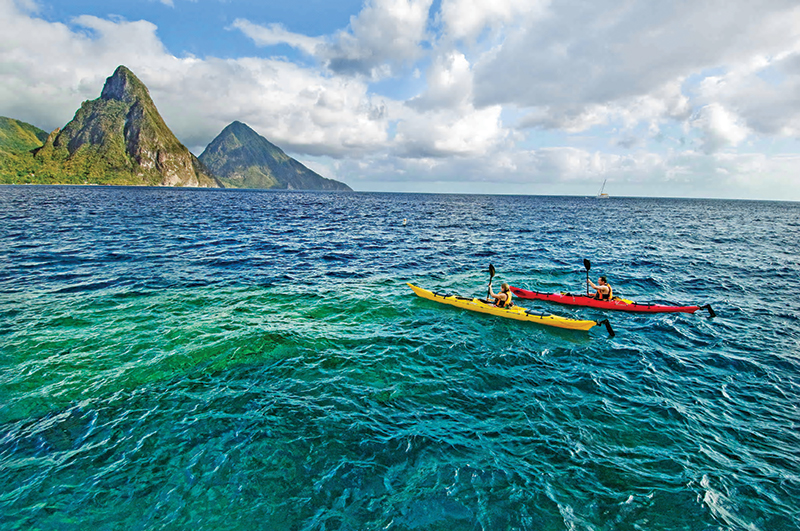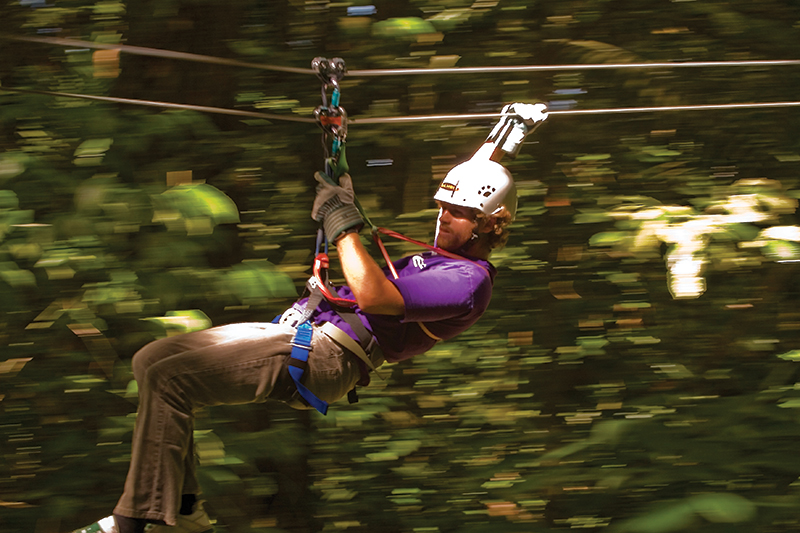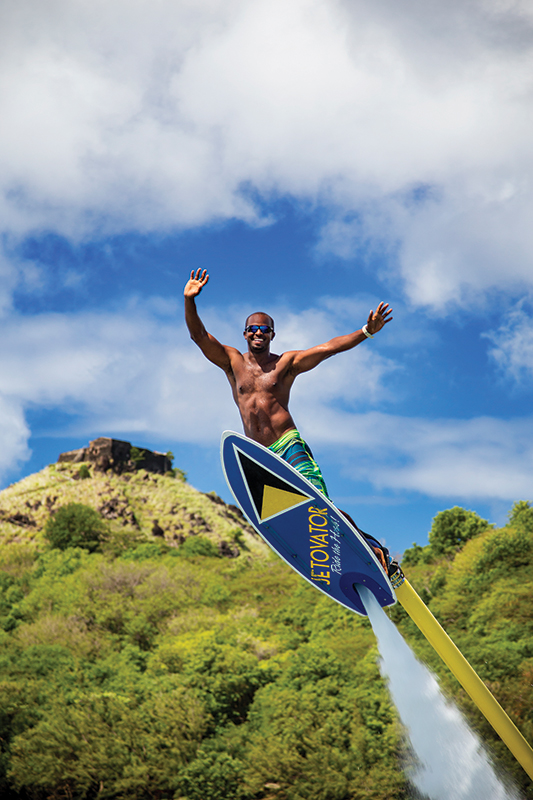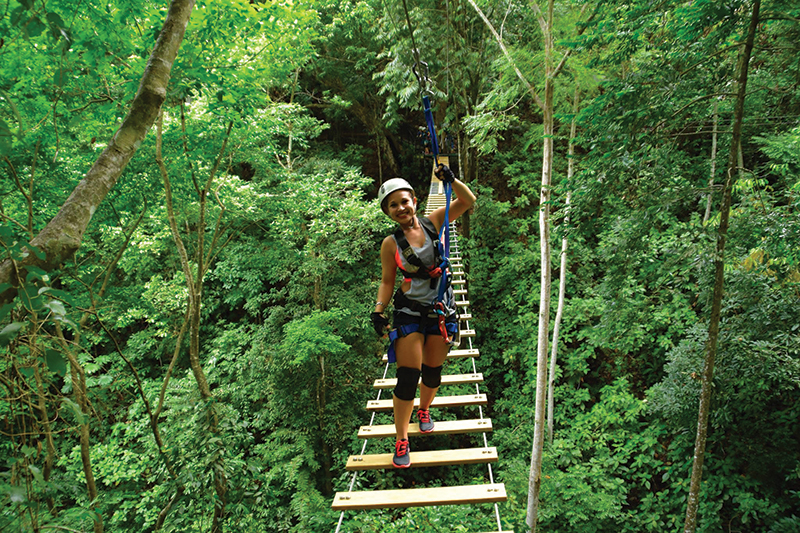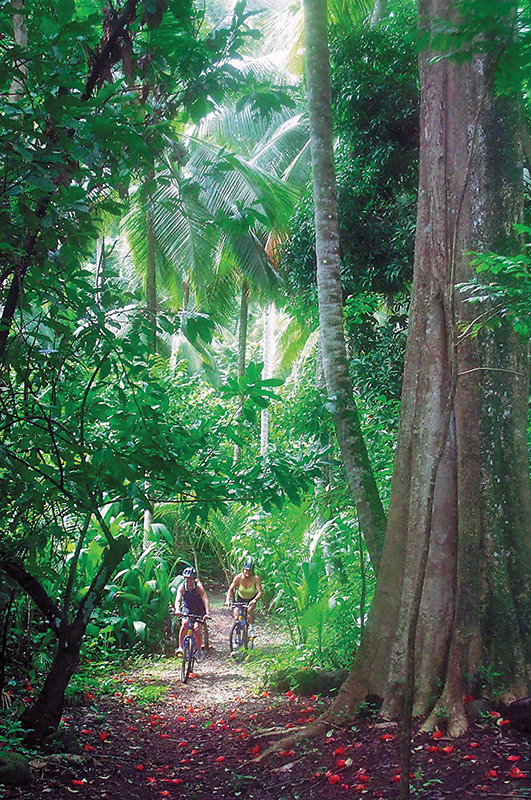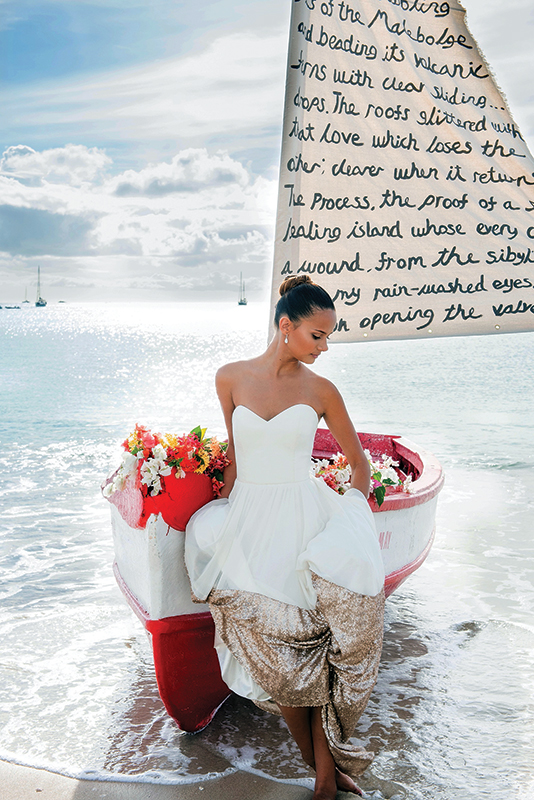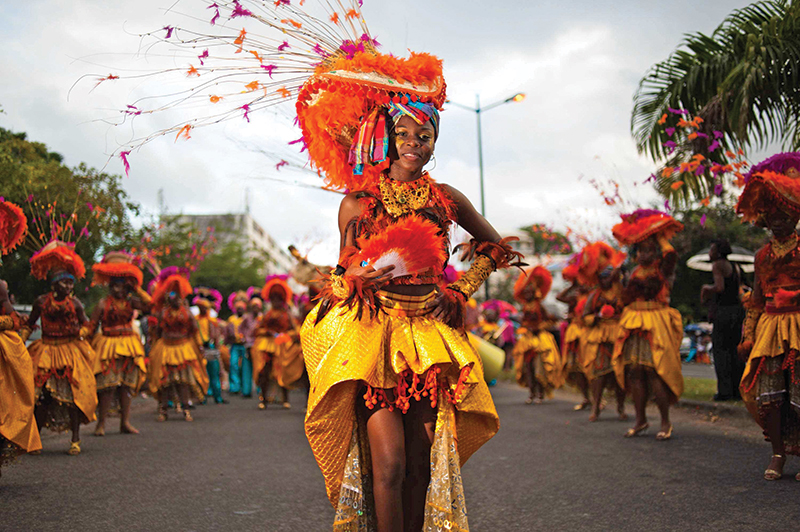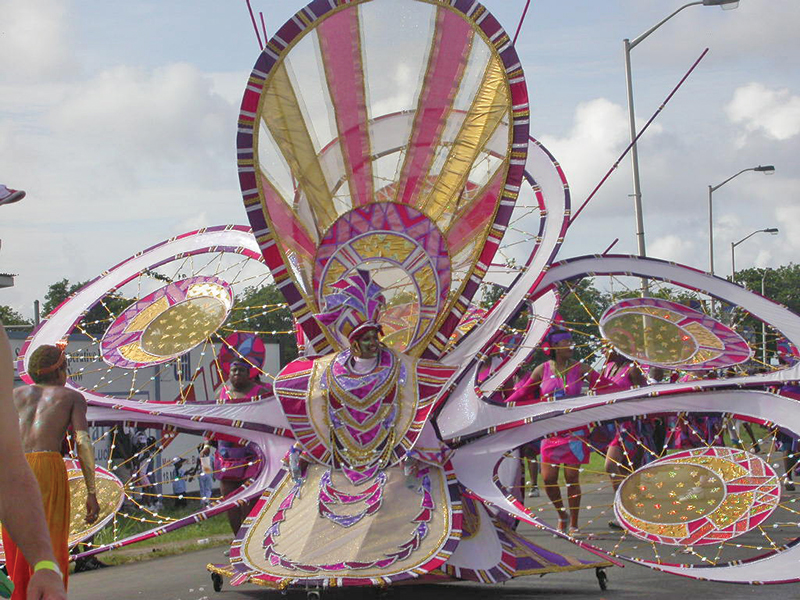The Kingdom of Nature
There is a place that has been able to maintain an unspoiled state, free from large buildings, industries or overexploitation of its resources. It exists permanently in bloom with hundreds of species that emanate exquisite fragrances and decorate their transparent environment. An island with the name of a woman: Saint Lucia. Travelers who leave its shores similarly describe the experience as having come close to paradise.
“There is a legend that says that Antilleans believed trees were mystical and symbolical stairs, a bridge between heaven and earth, ancestral beings that roamed the earth.”
Mito antillano
There is a veil of oblivion that surrounds the settlements that inhabited the Antilles before 1492. There have been considerable efforts to promote research on the origin of Saint Lucia, whose Amerindian names are Ioüanalao and Hewanorra (where the iguana is found), initiated by the island’s Archaeological and Historical Society (AHS), founded more than 50 years ago. The St. Lucia National Trust and the St. Lucia National Archives, along with a group of archeologists from Florida Museum of Natural History (FLMNH) and the Faculty of Archeology from the Leiden University in the Netherlands, have tried to unravel and find this elusive trace.
However, they have reached several conclusions and theories: the Arawak (a number of indigenous groups from the east of Brazil that expanded towards the Amazonia, coasts and isles of the Caribbean, Colombia, the Guianas and Venezuela), arrived 1800 years ago to the east coast of Grand'Anse and to Anse Noire from the South, where they built large settlements and a great culture. Ceramic urns, masks, clay statuettes, stamps to apply patterns with natural ink, fabrics, cooking utensils, and tools to cultivate earth and the gardens have been found along the coasts or territories at a considerable distance from the villages. They were without a doubt excellent navigators and ship builders. The petroglyphs and other discovered objects in the banks of the Balembouche River confirm ceremonial activities, and serve as testament of a dynamic relationship between the islands and the continent through commerce and trade. Around 1400 BC, they apparently left the area.
The presence of Caribs in Saint Lucia during colonization has been confirmed. What isn’t verifiable is that they practiced cannibalism, as Spaniards attested. It is evident that they were great strategists and brave warriors that kept conquerors at bay through alliances with the inhabitants of neighboring islands, until the end of the 17th century. Saint Lucia’s best-known archeological site is at Pointe de Caille, although there are substantial areas of the island that remain archeologically unexplored. Aboriginal heritage survives within its descendants, in language, in the name of some flowers, fruits, food, and places.
Saint Lucia is a small, insular country of 616km2, out of which 158 km are coasts. It’s located in the Lesser Antilles, southeast in the Caribbean Sea. The closest territories are Martinique to the north, Barbados to the southeast and Saint Vincent and the Grenadines to the south. It is said that Christopher Columbus named the island after Saint Lucia of Syracuse during his fourth voyage to the Caribbean, on December 13, 1502. According to other theories, Juan de la Cosa, navigator and cartographer, was the first to arrive to the island and the first to draw a map of what was known of the Americas. Something that is confirmed by history is the existence of a terrestrial globe in possession of the Vatican that year, and a certificate from 1511, where the island appears with its current name, described as property of the Spanish monarchy. However, there is no record of Spanish presence in the territory.
In 1550, pirate raids began. The famous buccaneer François le Clerc (Jambe de Bois or Peg Leg), who was the first to obtain a letter of marque from King Henry II of France, turned Pigeon Island into a lair for him and his crew of 330 men. They used the island to seize the treasures from the ships that sailed across the surrounding waters. He seemingly managed to come to an agreement with the Carib ethnicities on the island.
From 1588, the African slave trade expanded through the Antilles. In 1605, an English ship arrived to the shores and attempted to settle there, but they abandoned the island after constant conflicts with the Caribs. 1635 marked the beginning of a struggle between British and French over possession of the island. France was the first to officially claim it; in 1639 the British attempted to build settlements, which were ultimately destroyed by the Caribs. In 1643 the French returned and remained there; a few years later they signed a treaty with the Caribs, and the island became an official colony of the Crown Dependency of Martinique in 1674. From the 1700's onwards, 63 years worth of battles between the two empires took place, alternating power over Saint Lucia; the conflict came to an end in 1763 with the Treaty of Paris, which declares the island under French rule. Years later, in 1793, they proclaimed the abolition of slavery.
Barely two years later, in 1795, the British reclaimed control of the island and resumed slavery until its definite abolition in 1836. After the Napoleonic wars in 1814, Great Britain established its predominance in Saint Lucia, and in 1967 it became a member of the West Indies Associated States, with internal autonomy. They gained their independence in 1979. It is because of these political struggles that it is both part of the British Commonwealth and the International Organisation of La Francophonie. Additionally, because of the relentless strife between the two nations over the island, it was nicknamed the “Helen of the West Indies.” This allegory served as inspiration for Omeros by Derek Walcott, awarded with the Nobel Prize in Literature in 1992.
Nowadays, Saint Lucia is a member of the Caribbean Community (CARICOM). Their goals include strengthening bonds, promoting and stimulating economic, educational, cultural, and industrial cooperation between members. There is a potential growth in tourism, in port, hotel, and airport infrastructure. Bananas, cocoa, and citruses are their main source of exportation. On the other hand, they have joined the international finance circuit, and their legislation—which exempts foreign investors who hold bank accounts, or are members of associations in the territory, from paying taxes—could accelerate the desired economic growth.
English, French and Kéweyòl (French Creole or patois) are the most commonly used languages. The latter embodies words historically influenced by an African grammatical structure, Carib, and a vast French vocabulary; despite this, it is widely understood throughout the Lesser Antilles.
Saint Lucia has a population of 161,000, and 95% have African roots. Its government is a parliamentary democracy; Queen Elizabeth II, British monarch, is Head of State, represented by a Governor-General. The head of government is the prime minister, who is elected by the bicameral parliament in legislative suffrages. The Judicial Branch led by the Supreme Court of the Eastern Caribbean has jurisdiction in Anguilla, Antigua and Barbuda, the British Virgin Islands, Dominica, Grenada, Montserrat, Saint Kitts and Nevis, Saint Vincent and the Grenadines and Saint Lucia.
The Perfect Destination
Saint Lucia has a volcanic origin; from north to south it is possible to admire a mountain range with thick vegetation. The highest peak is Mount Gimie (950m). The island offers enough touristic infrastructures along with its natural attractions: beautiful islands, a spectacular mountainous panorama, inactive volcanoes with waterfalls and geothermal sulfur springs of healing properties. There are also many touristic routes, some of them focused on historical and cultural heritage, beaches, marinas, ports, and delicious gastronomy, as well as the interaction with the locals, who are welcoming, lively and sharing. Let us begin a tour through Saint Lucia’s most attractive features.
Castries is the capital, founded by the French in 1650, which has needed substantial restoration four times due to separate fires. It is possible to land on the island at the George F. L. Charles just outside the city, but international flights usually land at Hewanorra International Airport in Soufrière, second most important city in the country. Some of the best points of departure are selected cities in the United States, England and Canada. Airlines that offer flights to Saint Lucia are: Delta Airlines, United, British Airways through Barbados, Virgin Atlantic and Air Canada. From other Caribbean islands BWIA/Caribbean Airlines,LIAT and Air Caraibes offer flights to the island.
The best way to move around Saint Lucia is by sea, connected by cruise ships that dock along the coasts. In Castries they do so in two terminals: La Place Carenage and Pointe Seraphine, both featuring tax-free shopping centers, restaurants, ATMs, among others. Commercial ships are available at Port Castries and Vieux Fort.
When it comes to recreational vessels and private yachts—which are, without a doubt, the best way to visit Saint Lucia—, they offer special services in Rodney Bay, popular because it has showers, restaurants, pools, ship maintenance, and supermarkets along with five docks with 232 parking spots for boats up to 12ft. long. Another location worth mentioning is Marigot Bay, considered one of the most beautiful of the Caribbean, recently remodeled. There, we can find the Discovery resort, which includes accommodation, spa, restaurants, bars, boutiques, and an adjacent marina. This bay can harbor big ships, with a minimal depth of 15ft. It is a Port of Entry to Saint Lucia with the full range of Customs & Excise, Immigration, SLASPA and Ports Police. The ports also offer tax-free fuel, shipyards with repair facilities, luxury yacht availability and proximity to land.
• Rodney Bay Marina
+758-572-7200
VHF Channel 16
http://www.igy-rodneybay.com/
• Marigot Bay
+1 758-519-2122
http://www.marigotbay.com/
Visitors who didn’t arrive on a yacht can navigate in water taxis along the coasts. In the mainland, car rental, taxis and minibuses are available. It is also possible to rent helicopters, which offer a privileged aerial view of the island. Except for the capital, all regions are rural, and this will allow visitors to connect with the gifts of the lush nature, since it has been jealously cared for by natural conservation groups in recent years.
Shopping
One of the most recommended places to shop is the Duty Free Pointe Seraphine, located just outside of Castries, offering restaurants, boutiques, car rental, travel agencies, souvenirs, perfumes, jewelry, porcelain, glassware, art, antiquities, designer wear, and local products.
Baywalk Shopping Mall in Rodney Bay: a new shopping option with 50 stores, restaurants, casino, supermarket, open all seven days of the week, and is ideally located close to the touristic hub in Castries.
- Castries Santa Lucía 758
Castries Saint Lucia 758
+ 1 758-457-3425
This email address is being protected from spambots. You need JavaScript enabled to view it.
http://www.pointeseraphine.lc/
De lunes a viernes 9:00 a.m. – 4:30 p.m.
Sábados: 9:00 a.m. – 2:00 p.m.
- P.O. Box BW 300, Rodney Bay, Gros Islet,
Santa Lucía / Saint Lucia
1 (758) 452-6666 | +1 (758) 453-6666
The Piton Mountains
Symbolic of Saint Lucia, these volcanic cones are the first aspect of the island to be noticed. They appear to be twin mountains, but that’s not the case: Gross Piton has an elevation of 770m, while Petit Piton reaches 743m; both are joined by the Piton Mitan ridge. All of them are part of a Marine Management Area listed as World Heritage by UNESCO in 2004.
There is a region in Dominique where direct descendants of the Caribs reside; it is a 15km2 area granted as their territory and recognized by the British monarchy in 1903. Furthermore, black Caribs, known as the Garifuna people, have lived in Roatán (Honduras) for 300 years.
It encompasses 11km of coasts, part of the continental platform that descends approximately 75m, fringing reefs that cover almost 60% of the area, and enclosed coral regions, rocks and sandbars. Here, 68 fish species can be found, 60 Cnidarians: a group of polyps, anemone, corals, jellyfish, etc. There are also eight species of mollusks, 14 sponges, 11 kinds of Echinodermata (sea urchins, starfish and others), 15 arthropods (crabs, shrimp, lobsters) and six annelids. Along the coasts there are Hawksbill sea turtles, whale sharks and several species of baleen whales
Likewise, the protected area on the mainland includes rainforests. 148 plant species, 27 bird species, three of rodents, opossums, three species of bats, eight reptiles, and three amphibians inhabit Gros Piton, and 97 plant species in Petit Piton. There are also eight endemic species of trees and shrubs, besides a field with beneficial thermal waters. A visit to this area guarantees a day full of adventures and enjoyment of the wonders of nature, land and sea.
Info: Gros Piton: http://www.grospiton.com/
Tel: (758) 486-1561 / 1 (758) 717-8604
Waterfalls and the Diamond Botanical Gardens
Flowing from a natural protected fissure at the foot of the Piton Mountains, near Soufrière, in the coasts of Saint Lucia, it is considered the oldest botanic garden in the island. It is also a historical site; it was granted to the Devaux brothers by King Louis XIV (known as the Sun King, who reigned during 77 years) for their service to France. To this day, the 8km2 that comprise it belong to their descendants. Joan Du Boulay Devaux keeps the beautiful gardens full of exuberant flowers. Additionally, the king funded the construction of a house with 12 stone baths for his troops, which was destroyed during one of the confrontations. Apparently Empress Joséphine Bonaparte visited the gardens on her way to her father’s plantation on a neighboring island. In 1930, two of those baths were restored, and more were added recently in the exterior. The water used in the baths and from the waterfall is nurtured by the inactive volcanoes and their subterranean thermal waters. These are only a few of the charms you will be able to enjoy in this splendid location.
- Soufrière Estate P.O. Box 1020 Soufrière, Santa Lucía / Saint Lucia
+1-758-459-7155
This email address is being protected from spambots. You need JavaScript enabled to view it.
The Balenbouche Plantation
Another place worth visiting is the plantation located by the shores of the Balenbouche River, where it is possible to find significant archeological and historical treasures from the island. In the 1770s, the plantation was established with the purpose of producing sugar and rum. Throughout time, it changed ownership many times. The Piaye community, close to the plantation, was founded by former slaves and it preserves an African essence. Since1964, the plantation belongs to the Lawaetz family, who has been dedicated to the restoration of the buildings and the diversification and production of new crops, like star fruit, passion fruit, ginger lilies, vegetables and tobacco. The family is well-respected by the community and the authorities; they are active members of the Heritage Tourism Association of Saint Lucia (HERITAS). They have preserved the main house from the XIX century and the aqueduct (200 years old), among other structures. Research projects still prevail in the 75 hectares that provide a mostly unspoiled habitat for trees, plants, cultivation, wildlife and many bird species. Within the plantation, there is a hotel, villas for rent, and apartments; it offers restaurants, yoga classes, excursions, healing retreats, meditation, special events, and art workshops, among many others—all of this within its invaluable and bountiful nature.
- Balenbouche Estate P.O. Box VF 707,
Gablewoods South,Santa Lucía / St. Lucia
This email address is being protected from spambots. You need JavaScript enabled to view it.
+1(758) 455-1244
+1(758) 724-2667
Cathedral Basilica of the Immaculate Conception in Castries
Built in 1897, it is classified as the largest church in the Caribbean islands. It is the seat of the Archbishop in Castries, dedicated to Virgin Mary, Lady of the Immaculate Conception. It was granted the status of Minor Basilica on May 11, 1997, 100 years after it was built. The renowned Saint Lucian artist, Dustan St. Omer, designer of Saint Lucia’s national flag, painted the colorful murals. The interior is a mixture of architectonical styles with a Caribbean essence. The basilica’s doors remain open every day, just like every church in the area, among which are Church of St. Peter and St. Joseph the Worker Church. Catholic churchgoers comprise 61.5% of the population.
Pigeon Island
Because of its location, it played an important role in the history of the Caribbean, and it is possible to visit the ruins of the barracks used by soldiers as a British naval base as well as other ancient structures. There is a natural park along a wide beach—another highly visited location.
Adventure and Watersports
Saint Lucia is the perfect spot for water sports, offered by resorts or specialized companies; among this attractive offer we can recommend dinghy sailing, sailing, parasailing, kayaking, and dolphin, shark, whale and other aquatic mammal sightings. Windsurf and waterski are also good options. Diving in the Caribbean will certainly be an unforgettable experience with an underwater volcano, reefs with vast coral diversity; submerged mountains serve as shelters for aquatic flora and fauna. These are some of the adventures that await. Activities on land include zip lining, rainforest hiking, trekking, climbing, etc.
Other Locations and Attractions
You can visit the rum distillery in Hacienda Mamiku and follow the route of west coast heritage, idyllic for bird watching, to enjoy creole gastronomy, the traditional music along with Afro-Caribbean dances and other traditions, as well as the picturesque fishing villages. Friday turns into a full-fledged party in Gros Islet. In the morning, you can visit the hundred-year old market in Castries, or the historic ruins of Fort Rodney Hill, the National Forest Reserve spanning 76.89 km2, and the zoo, adjacent to Union Road, en route to Babonneau. You shouldn’t miss the opportunity to visit the volcanic center Qualibou in Soufrière. There is a network of roads that lead to it, and once there, you can enjoy the sulfur springs. Additionally, Saint Lucia is considered as a special destination for wedding celebrations; it is ranked in the first place internationally.
Festivities
Throughout the year, several social events take place; the carnival is their main festivity, and it takes place between February and March. In May, the St. Lucia Jazz Festival lasts four days. October 28 is the International Creole Day, and December 13 is the National Day of Saint Lucia.
Text: Maruchy Behmaras ± Photo: CAPELLA HOTEL / VISION ST LUCIA / SUCV / ADSG / FRANCISGRENADA / OGO CT / GRFA / POSUGA / TROS / MIKKELPAI / TIQT / DFRON / DESTINATIONS SAINT LUCIA / REDBUKA / COFW / ADVANTAGETOURS / KUONI / ROD SLAV / BART / SELCA / SIMPLYSOUFRIERE / BEST ST LUCIA / XTREME ST LUCIA / MELI L / AS DF / COMPHOTOS / TPC / AS / CO / ST LUCIA TRAVEL / WIXTAC / RFR / ASMJN / STONE FIELD / BIKING / IJNANYA ISSAC / © CHRISUKPHOTO / © AMANDA MELONES / © ERIC BRINKMAN / © / / LAWRENCE WESLOWSKI JR / © ATGIMAGES / © NICHOLAS JONES / © KEVIN PANIZZA / CASTRIES IS THE CAPITAL OF THE ISLAND OF ST RASADERA / © CRAIG DOROS / © / MBRECHWALD / © DENNIS SABO / © GERARDO BORBOLLA / © ALEX.TREFILOV / © ALCODESIGN

